什么是序列化和反序列化?
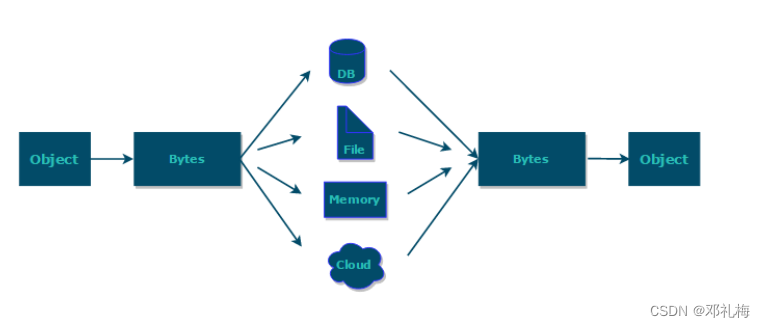
- 把对象转换成字节序列
- 把字节序列恢复成对象
结合OSI七层协议模型,序列化和反序列化是在那一层做的?
在OSI七层模型中,序列化工作的层级是表示层。这一层的主要功能包括把应用层的对象转换成一段连续的二进制串,或者反过来,把二进制串转换成应用层的对象。
为什么要使用序列化?
序列化的作用是将对象转换为可以存储或传输形式的过程,这样对象可以存储在内存或文件中(内存或文件实际上是以字节为单位的),我们要转换成机器能够认识的单位。比方说我们需要把一个对象传输到另一台机器
网络传输,跨机器,要转换成机器能识别的格式,反之
Serializable接口的作用
做标记,实现Serializable接口的类表示可以序列化,告诉程序实现了它的对象是可以被序列化的。如果对某个没有实现Serializable接口的类直接序列化将会报”NotSerializableException“错误。
这个时候有些人就会想:当对象中的某些信息,比方说密码或身份证,我不想暴露有没有什么办法?当然JDK已经给我们想到了这些问题,为了保障数据的安全性,当实现serialVersional接口实现序列化的时候可以使用transient或static关键字修饰某个字段,被修饰的字段就不会被序列化,反序列时也不会被持久化和恢复,会被置成默认值
//因为序列化保存的是对象的状态,而 static 修饰的字段属于类的状态,因此可以证明序列化并
//不保存 static 修饰的字段。
public static Long cardId;
// transient临时修饰成员,阻止字段被序列化
//当对象被反序列化时,被transient修饰的变量值不会被持久化和恢复,会被置成类型默认值
private transient String password;
注意:
普通对象序列化和反序列化返回的是两个不同的对象
枚举类型序列化的对象是static final的,不会回收,所以反序列化回来的对象和原来的对象是同一个
序列化和反序列化的方式有哪些?
- JDK自带序列化方式
- Kryo
JDK自带序列化方式
Student类
package org.example.SerializableTest;
import lombok.Data;
import java.io.Serializable;
@Data
public class Student implements Serializable {
private static final long serialVersionUID = 1L;
public Student(String name,Integer age,Integer score,Integer studentId,String password){
this.name=name;
this.age=age;
this.score=score;
this.studentId=studentId;
this.password=password;
}
private String name;
private Integer age;
private Integer score;
private Integer studentId;
// transient瞬态修饰成员,不会被序列化
//当对象被反序列化时,被transient修饰的变量值不会被持久化和恢复,会被置成类型默认值
private transient String password;
}
序列化:
Student student = new Student("唐三", 18, 100, 001, "123456");
try {
FileOutputStream fos = new FileOutputStream("dlm.txt");
ObjectOutputStream oos = new ObjectOutputStream(fos);
oos.writeObject(student);
oos.close();
} catch (IOException e) {
e.printStackTrace();
}
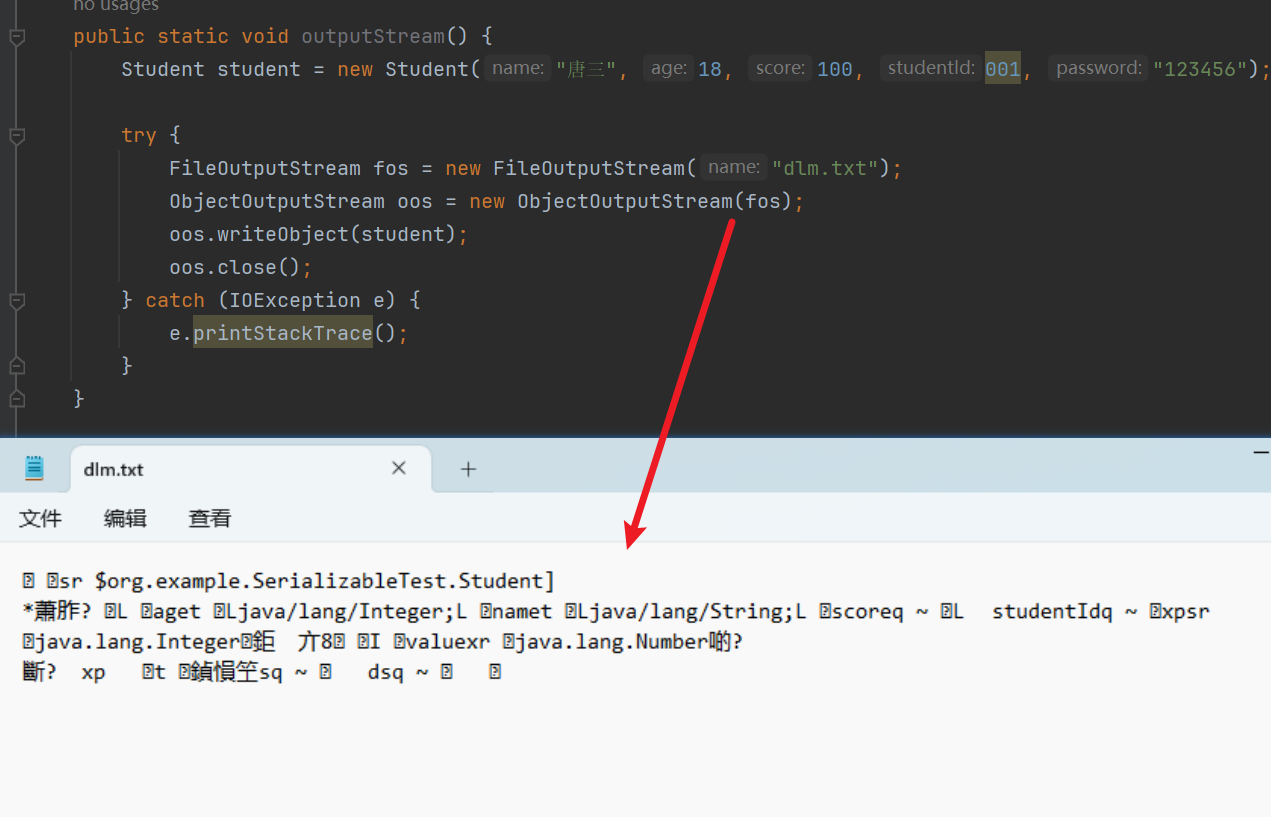
反序列化:
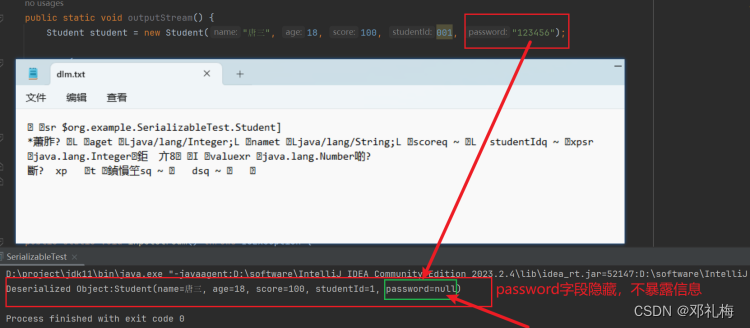
通过输出文件中的对象我们可以发现用transient修饰的password字段被隐藏了,保证了信息的安全
在Student类中不知道大家有没有发现serialVersionUID这个字段,这个字段的作用用来验证版本的,对版本进行表示。在序列化的时候会记录将serialVersionUID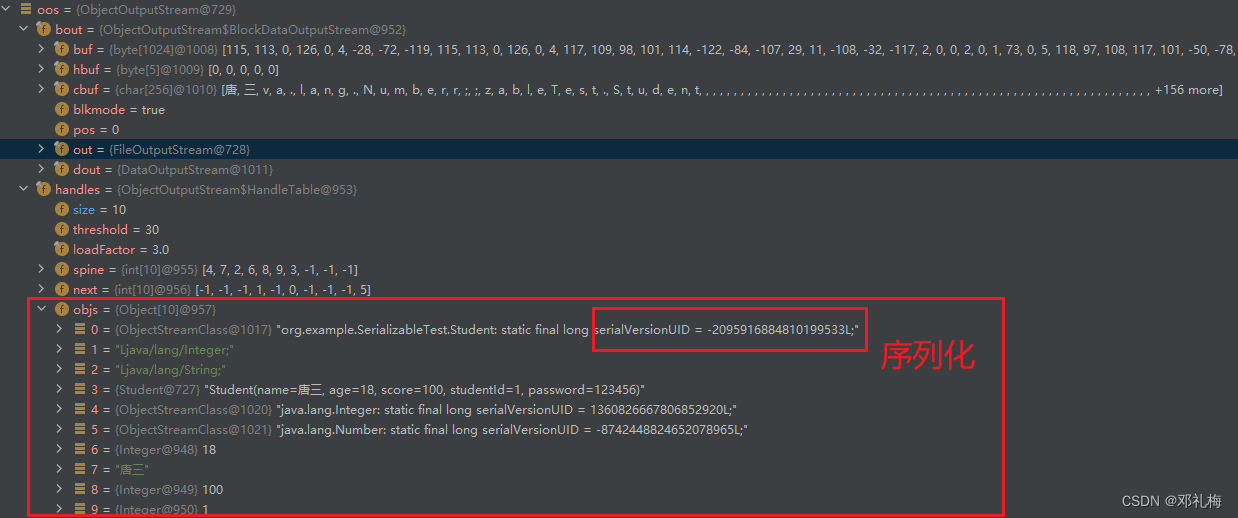
在反序列化的时候将serialVersionUID和本地实体类的serialVersionUID进行比较,如果一致则可以反序列化,否则则说明序列化版本不一致
serialVersionUID默认是“1L”,可以自动生成
Kryo
是一个支持序列化/反序列化的工具
KryoStudent类
package org.example.SerializableTest;
import lombok.Data;
@Data
class KryoStudent {
public KryoStudent() {
}
public KryoStudent(String name, Integer age, Integer score, Integer studentId, String password) {
this.name = name;
this.age = age;
this.score = score;
this.studentId = studentId;
this.password = password;
}
private String name;
private Integer age;
private Integer score;
private Integer studentId;
private transient String password;
@Override
public String toString() {
return "KryoStudent{" +
"name='" + name + '\'' +
", age=" + age +
", score=" + score +
", studentId=" + studentId +
", password='" + password + '\'' +
'}';
}
}
package org.example.SerializableTest;
import com.esotericsoftware.kryo.Kryo;
import com.esotericsoftware.kryo.io.Input;
import com.esotericsoftware.kryo.io.Output;
import org.objenesis.strategy.StdInstantiatorStrategy;
import java.io.FileInputStream;
import java.io.FileNotFoundException;
import java.io.FileOutputStream;
public class KryoDemo {
public static void main(String[] args) throws FileNotFoundException {
//创建一个 Kryo 对象
Kryo kryo = new Kryo();
//将对象进行注册
kryo.register(KryoStudent.class);
KryoStudent object = new KryoStudent("唐三", 18, 100, 001, "123456");
//序列化
Output output = new Output(new FileOutputStream("dlm.txt"));
//将 Java 对象序列化为二进制流
kryo.writeObject(output, object);
output.close();
Input input = new Input(new FileInputStream("dlm.txt"));
//将二进制流反序列化为 Java 对象
KryoStudent object2 = kryo.readObject(input, KryoStudent.class);
System.out.println(object2);
input.close();
}
//反序列化
public void setSerializableObjectStudent() throws FileNotFoundException {
Output output = new Output(new FileOutputStream("dlm.txt"));
Kryo kryo = new Kryo();
kryo.setReferences(false);
kryo.setRegistrationRequired(false);
kryo.setInstantiatorStrategy(new StdInstantiatorStrategy());
kryo.register(KryoStudent.class);
}
}
Kryo方式有什么缺点吗?
- 不是线程安全的,每个线程都有自己的Kryo对象、输入和输出实例
- 只支持Java实现
既然JDK和Kryo都可以进行序列化和反序列化,那分别用JDK和Kryo提供的序列化和反序列化方式对10000个对象进行转换,从时间上我们来看一下它的性能
JDK和Kryo性能对比
Student类
import lombok.Data;
import java.io.Serializable;
@Data
public class Student implements Serializable {
public Student(String name, Integer age, Integer score, Integer studentId, String password){
this.name=name;
this.age=age;
this.score=score;
this.studentId=studentId;
this.password=password;
}
private String name;
private Integer age;
private Integer score;
private Integer studentId;
// transient瞬态修饰成员,不会被序列化
private transient String password;
}
KryoStudent类
import lombok.Data;
@Data
class KryoStudent {
//Kryo不支持包含无参构造器类的反序列化,所以需要把无参构造器显示出来。
public KryoStudent() {
}
public KryoStudent(String name, Integer age, Integer score, Integer studentId, String password) {
this.name = name;
this.age = age;
this.score = score;
this.studentId = studentId;
this.password = password;
}
private String name;
private Integer age;
private Integer score;
private Integer studentId;
private transient String password;
@Override
public String toString() {
return "KryoStudent{" +
"name='" + name + '\'' +
", age=" + age +
", score=" + score +
", studentId=" + studentId +
", password='" + password + '\'' +
'}';
}
}
JDK序列化和反序列化
import com.esotericsoftware.kryo.Kryo;
import com.esotericsoftware.kryo.KryoException;
import com.esotericsoftware.kryo.io.Input;
import com.esotericsoftware.kryo.io.Output;
import org.junit.Test;
import java.io.*;
import java.util.ArrayList;
public class test5 {
//序列化
@Test
public void test1() throws Exception {
long time = System.currentTimeMillis();
ObjectOutputStream oos = new ObjectOutputStream(new FileOutputStream("dlm.txt"));
for (int i = 0; i < 10000; i++) {
oos.writeObject(new Student("唐三", 18, 100, i, "123456"));
}
oos.close();
System.out.println("JDK序列化消耗的时间" + (System.currentTimeMillis() - time));
}
//反序列化
@Test
public void test2() throws Exception {
long time = System.currentTimeMillis();
ObjectInputStream ois = new ObjectInputStream(new FileInputStream("dlm.txt"));
Student student = null;
try {
while (null != (student = (Student) ois.readObject())) {
}
} catch (EOFException e) {
}
System.out.println("JDK反序列化消耗的时间" + (System.currentTimeMillis() - time));
}
}
Kryo序列化和反序列化
import com.esotericsoftware.kryo.Kryo;
import com.esotericsoftware.kryo.KryoException;
import com.esotericsoftware.kryo.io.Input;
import com.esotericsoftware.kryo.io.Output;
import org.junit.Test;
import java.io.*;
import java.util.ArrayList;
public class test5 {
//序列化
@Test
public void test1() throws Exception {
long time = System.currentTimeMillis();
Kryo kryo = new Kryo();
//将对象进行注册
kryo.register(KryoStudent.class);
Output output = new Output(new FileOutputStream("dlm.txt"));
//存储10000个对象
for (int i = 0; i < 10000; i++) {
kryo.writeObject(output, new KryoStudent("唐三", 18, 100, i, "123456"));
}
output.close();
System.out.println("Kryo序列化消耗的时间" + (System.currentTimeMillis() - time));
}
//反序列化
@Test
public void test2() throws Exception {
long time = System.currentTimeMillis();
Kryo kryo = new Kryo();
kryo.register(KryoStudent.class);
Input input = new Input(new FileInputStream("dlm.txt"));
KryoStudent student = null;
//反序列化文件中的对象
try {
while (null != (student = kryo.readObject(input, KryoStudent.class))) {
}
} catch (KryoException e) {
}
input.close();
System.out.println("Kryo反序列化消耗的时间" + (System.currentTimeMillis() - time));
}
}
结果为:
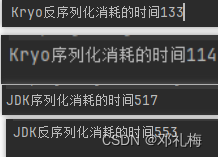
从输出结果上我们发现时间上有很大的不同,Kryo序列化和反序列化相比于JDK都快很多,那为什么会产生这样的结果呢?
- Kryo依赖于字节码生成机制(底层使用了ASM库)
- Kryo序列化时,只将对象的信息、对象属性值的信息等进行序列化,没有将类field的描述信息进行序列化,这样就比JDK自己的序列化结果要小很多,而且速度肯定更快。
- Kryo序列化出的结果是其自定义的、独有的一种格式,因此像redis这样可以存储二进制数据的存储引擎可以直接将Kryo序列化出来的数据存进去也可以选择转换成String的形式存储在其他存储引擎中(性能有损耗)
 序列化与反序列化详解:JDK与Kryo性能比较
序列化与反序列化详解:JDK与Kryo性能比较




 本文详细介绍了序列化与反序列化在OSI七层模型中的作用,探讨了Serializable接口和transient关键字的应用,比较了JDK和Kryo的序列化/反序列化方法,以及它们在性能上的差异。
本文详细介绍了序列化与反序列化在OSI七层模型中的作用,探讨了Serializable接口和transient关键字的应用,比较了JDK和Kryo的序列化/反序列化方法,以及它们在性能上的差异。
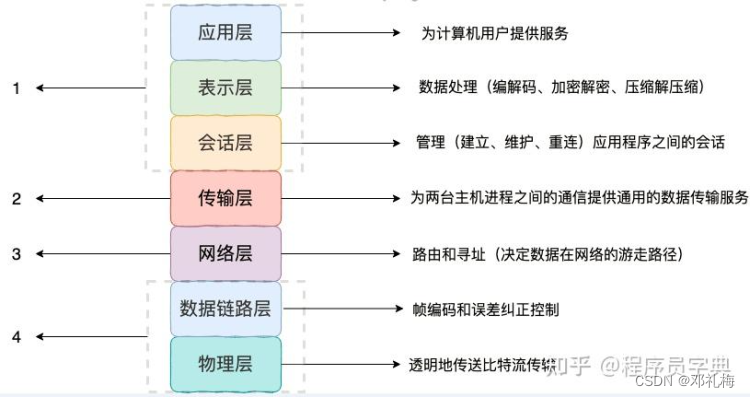

















 279
279

 被折叠的 条评论
为什么被折叠?
被折叠的 条评论
为什么被折叠?










